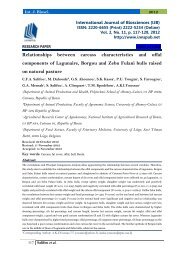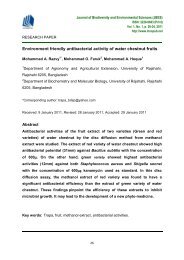Int. J. Biomol. & Biomed - International Network for Natural Sciences
Int. J. Biomol. & Biomed - International Network for Natural Sciences
Int. J. Biomol. & Biomed - International Network for Natural Sciences
Create successful ePaper yourself
Turn your PDF publications into a flip-book with our unique Google optimized e-Paper software.
24 <strong>Int</strong>. J. <strong>Biomol</strong>. & <strong>Biomed</strong>.<br />
Our results revealed that a pre-treatment of the rabbits<br />
with ATR, a muscarinic cholinoceptor antagonist,<br />
revoked the negative chronotrope and inotrope effects<br />
of ESera. These effects observed with ESera and<br />
suppressed in the presence of a cholinoceptor blocker<br />
showed that our plant extract could contain some<br />
cholinergic substances. It is known that acetylcholine<br />
(ACh) is a cardioinhibitory substance. It dercrease the<br />
cardiac activity acting on the membrane permeability<br />
at the sinoatrial node (node of Keith and Flack). ACh<br />
has muscarinic receptors in the cardiac muscle (Field<br />
et al., 1978). The binding of ACh on its muscarinic<br />
recpetors increase the potassium conductance (Sojima<br />
and Noma, 1984) and reduces the low calcium current<br />
(Hino and Ochi, 1980).<br />
The effects of ESera obtained on the ECG were in<br />
accordance with previous studies. These studies<br />
showed that the administration of sesame (S.<br />
radiatum) aqueous leaf extract to rabbits induced<br />
hypotension, which could result from both<br />
cardiodepression mechanism and vasorelaxation<br />
(Konan et al., 2006). The hypotension caused by ESera<br />
was comparable to those observed with<br />
pharmacodynamic substances used in gynaeco-<br />
obstetric cares (Konan et al., 2006). The hypotension<br />
induced by these substances (oxytocin and<br />
misoprostol) could contribute to facilitate childbirth<br />
(Zingg, 2001; Baskett et al., 2007).<br />
The hypotensive action of ESera could be due to the<br />
tannins, the flavonoids and the alkaloids found in the<br />
extract. The aqueous leaf extract of S. radiatum, as<br />
indicated with the phytochemical analysis, contained<br />
quinones, catechic tannins, flavonoids and alkaloids.<br />
These compounds were also found in<br />
Tabernaemontana pandaqui (Taesotikul et al., 1998),<br />
Arbustus unedo (Ziyyat and Boussairi, 1998), Lippia<br />
alba, Melissa officinalis, Cymbopogon citratus and in<br />
the majority of plants used traditionally in the<br />
treatment of arterial hypertension (Gazola et al.,<br />
2004).<br />
Konan et al.<br />
The cardiovascular actions of the plants could be due<br />
to the presence of the tannins, the flavonoids, and the<br />
alkaloids. The tannins and the flavonoids could relax<br />
the vascular endothelium whereas the alkaloids could<br />
cause a bradycardia (Ziyyat and Boussairi, 1998;<br />
Slowing et al., 2001). The alkaloids could act either by<br />
the stimulation of the cardiac muscarinic receptors or<br />
by blocking the calcium channel attributed, or the two<br />
mechanisms at the same time (Vasquez and Mefeiros,<br />
1998; Udoh and Lot, 1998).<br />
In conclusion, the study of S. radiatum aqueous leaf<br />
extract revealed that it has a low toxicity by<br />
intraperitoneal administration. This low toxicity<br />
permits its uses by populations. According to the<br />
phytochemical study of the leaves, S. radiatum leaves<br />
could have many pharmacological properties justifying<br />
its traditional use to treat many diseases including<br />
cardiovascular diseases and childbirth complications.<br />
Chemical and pharmacological studies are now in<br />
progress to isolate and characterize the constituents<br />
responsible <strong>for</strong> such effects, and also to investigate in<br />
more detail the mechanism underlying these actions of<br />
S. radiatum leaves.<br />
Competing interests<br />
The authors declare that they have no competing<br />
interests.<br />
Authors’ contributions<br />
All authors contributed equally in the study. They<br />
made substantial contributions to the design of the<br />
study, the collection of the data as well as the<br />
preparation and analysis of the data. They also drafted<br />
the manuscript and gave final approval <strong>for</strong> its<br />
submission to the journal <strong>for</strong> consideration of<br />
publication.<br />
Acknowledgements<br />
The authors are indebted to Professor Aké-Assi<br />
Laurent (Laboratory of Botany, Unité de Formation et<br />
de Recherche – Biosciences, University of Cocody at








